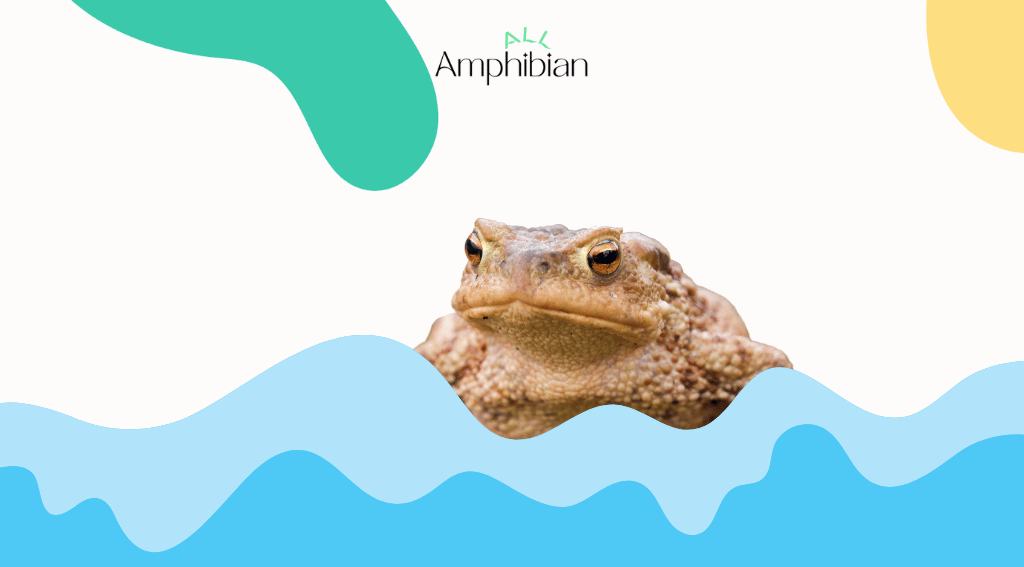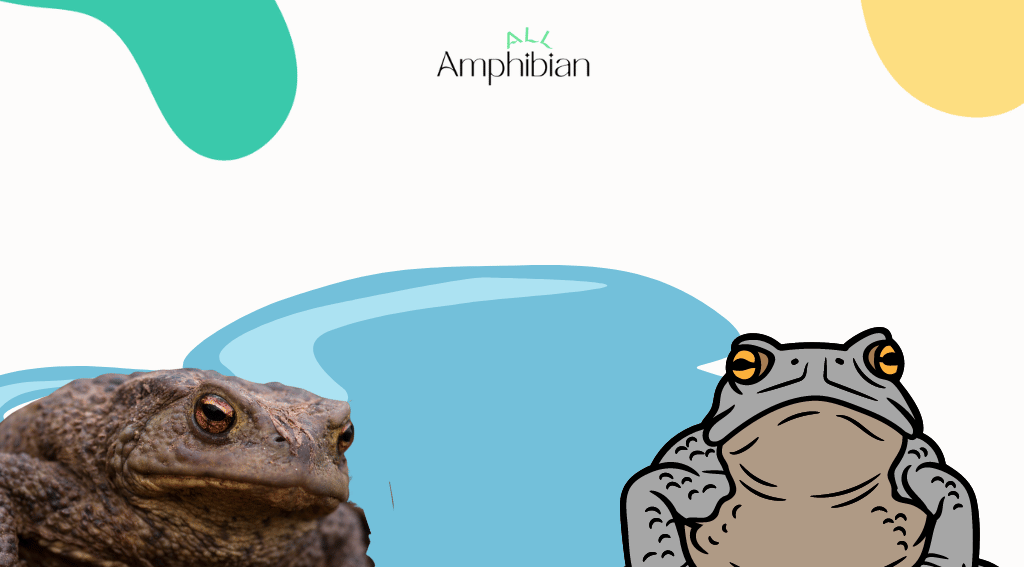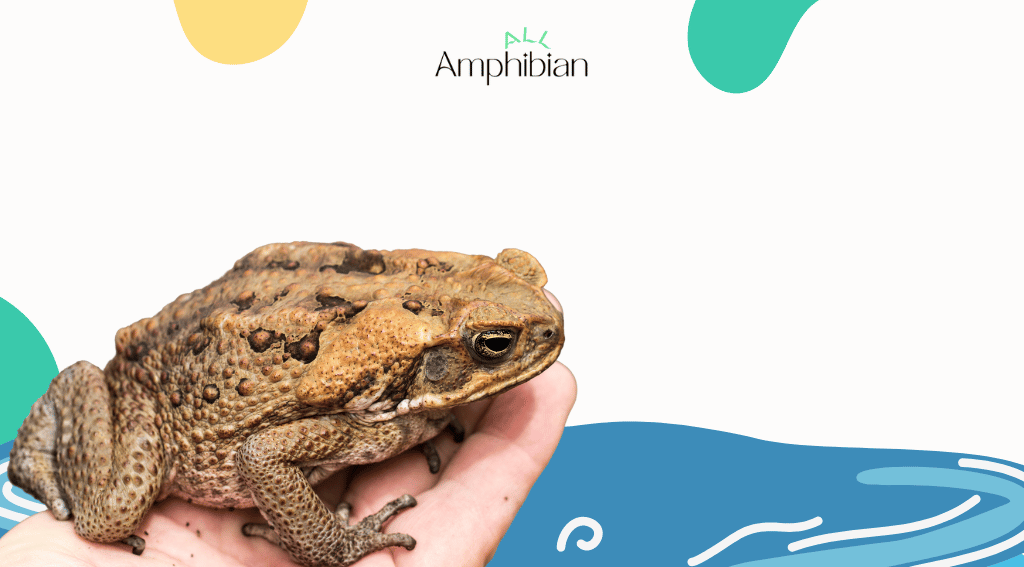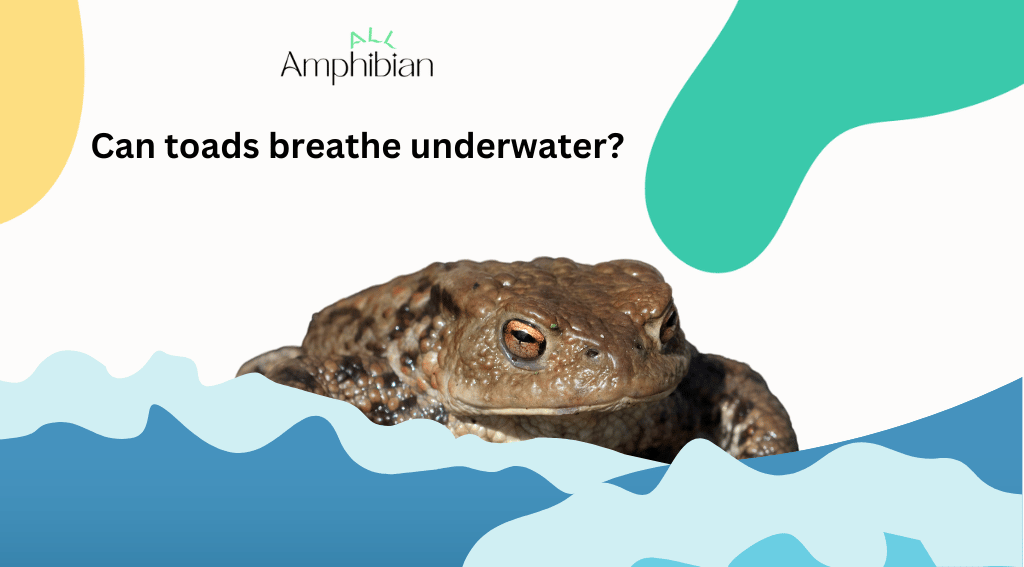Can toads breathe underwater? Toads are not dependent on water like frogs and spend most of their lives on land, but can they breathe underwater? Join us at All Amphibian as we explore this.
Can toads or toad tadpoles breathe underwater?
Toads are a type of frog. They start their life in water. As tadpoles, toads are completely aquatic, and like fishes, they have gills and can breathe underwater. But when they reach maturity, they undergo many changes.
They lose their tails, arms and legs become complete, and gills become lungs. Now they are no longer suitable for living in water and going to land. Toads return to the water only to mate.
They breathe with their lungs on land, but their lungs are not developed like humans and cannot provide them with the necessary oxygen. To compensate for this lack of oxygen, toads can breathe through their skin and the inner surface of their mouths.
Toad’s skin contains many capillaries and blood vessels that are very close to the surface of their skin and can absorb oxygen. For this reason, toads can breathe underwater.
How do toads breathe?

As we said, toads live mostly on land and breathe through their lungs, skin, and the membrane of the inner surface of their mouths. Their lungs are unlike humans, and They don’t have a diaphragm to take air into their lungs as we do.
For this reason, toads take air in and out of their lungs by raising and lowering the floor of their mouth. This work is like pumping and is known as Gular pumping. To do this, the toad closes its mouth, and by lowering the floor of its mouth, it causes expansion, and air enters through the nostrils.
Then toad closes its nostrils and raises the floor of its mouth. This causes air to enter its lungs due to contraction. In the lungs, air oxygen enters the blood, and carbon dioxide from its blood enters the air.
Then the toad lowers the floor of its mouth, and by creating air suction from the lungs, it returns to its mouth. Then the toad opens its nostrils and raises the floor of the ts mouth. By doing this, the air comes out through the nostrils. All these steps happen very quickly, and the toad inhales and exhales in this way.
How do toad tadpoles breathe?
Toads are aquatic at the beginning of their lives and breathe with their gills. The tadpoles have big heads, and their gills are located on both sides of their heads. They have an extensive network of very tiny blood capillaries that are close to the surface of their skin.
The oxygen in the water dissolves when it comes into contact with the tadpole’s gills and is absorbed by their bodies. This act is called diffusion. While the oxygen in the water enters the blood of the tadpoles, the carbon dioxide in the blood also enters the water and leaves their body.
Toads usually lay their eggs in stagnant water without current. Because these waters are stagnant, they usually have a low oxygen level. Therefore, the tadpoles suffer from a lack of oxygen.
For this reason, they usually develop their lungs in addition to their gills. And they come close to the surface of the water to breathe. When the tadpoles first hatch, they are not strong enough to overcome the surface tension of the water and breathe.
For this reason, they come to the surface of the water and open their mouths, and suck the water. By sucking the water, they create a small bubble on the surface of the water. Along with the water, they suck in some oxygen, too, and they breathe. Tadpoles do this until they have enough strength to overcome the surface tension of the water.
How do toads breathe underwater?
Toads can also breathe through their skin. Its skin has a network of blood capillaries. Oxygen dissolved in water enters the toad’s bloodstream through diffusion when it comes in contact with its skin.
At the same time, carbon dioxide also enters the water from its blood. But this does not provide all the oxygen needed by the toads, so the toads cannot stay underwater for a long time.
How long can toads stay underwater?

How long toads can stay underwater depends on various factors. The body metabolism of toads is also an effective factor, but in general, the factors that influence the breathing of toads underwater are:
The amount of oxygen in the water
The amount of oxygen in the water is very important. Still, waters usually have less oxygen than flowing waters. Because when the water is flowing and turbulent, more oxygen from the air mixes with the water. The number of aquatic plants is also very effective.
Because aquatic plants, such as algae, introduce oxygen into the water through photosynthesis during the day and take carbon dioxide from the water, but it is the opposite at night, as the oxygen level of the water, which has many plants, is higher during the day. Also, decaying plants have an effect.
On reducing water oxygen because of decomposing bacteria, use water oxygen to decompose them. Toads can last longer underwater with high oxygen content.
Temperature
Temperature also has a great effect on the breathing of toads underwater. Toads are cold-blooded creatures, and at high temperatures, their body metabolism increases, and their need for oxygen increases, and if the temperature is low, their body metabolism decreases, and they need less oxygen.
Also, temperature affects the amount of oxygen in water, and cold water usually has more oxygen than warm water. As a result, toads can stay underwater for a longer time in low temperatures and cold water.
Physical activity
Just like us, when we exercise and move, when we have high physical activity, our heart beats faster, and we need more oxygen, and our breathing becomes faster, but when we are resting, we breathe more slowly; Toads are the same way, and when they are very mobile and their physical activity is high, they need more oxygen. Therefore, toads can stay underwater for a longer time while resting.
How do toads breathe during hibernation?

Toads hibernate in winter because of the cold and to avoid freezing. They usually take shelter underground. Toads have powerful legs and sharp claws that are suitable for digging the ground. They use other animals’ abandoned nests and holes if they can.
Also, toads can dig the ground easily and hibernate under the ground. During hibernation, due to the reduction of oxygen in the toads’ shelter, it is not possible to breathe through the lungs. Toads usually breathe through their skin and absorb oxygen from soil moisture.
This amount of oxygen is very low, but toads are cold-blooded animals, and during hibernation, due to the decrease in temperature, their body’s metabolism drops so much that the same amount of oxygen they absorb through their skin is enough for them. At this time, all the toads’ blood flows toward their skin to receive more oxygen. This is how toads breathe during hibernation.
Conclusion
Toads are amphibians and have two life stages. They are completely aquatic in their first stage of life as tadpoles. Like fish, they have gills and can breathe underwater. The gills of the toads are located on both sides of their head and consist of a network of blood capillaries.
Oxygen dissolved in the water is absorbed through diffusion when it comes into contact with the gills of the tadpoles and enters their blood, and at the same time, carbon dioxide enters the water from their blood.
Due to the lack of oxygen in stagnant water, tadpoles usually expand their lungs in addition to their gills and come to the water’s surface to breathe. When the toads reach the age of puberty, they leave the water, their body undergoes changes, and lungs appear instead of gills.
Toads spend most of their lives on land and breathe through their lungs. But their lungs are not developed like humans and cannot provide them with enough oxygen. For this reason, toads can breathe through the skin and surface membrane inside their mouths.
Toads can breathe underwater. Their skin has many blood vessels and capillaries that are very close to the surface of the skin. When the oxygen in the water comes into contact with the toad’s skin, it is absorbed into their blood, which is called diffusion. Carbon dioxide also enters the water in the same way.
Various factors such as the amount of oxygen in the water, temperature, and physical activity, affect the time that toads can breathe underwater. On land, toads take air in and out of their lungs by raising and lowering the floor of their mouth. They go underground during hibernation, and due to the reduction of their body metabolism, they survive only through the oxygen in the moisture of the soil that they absorb through their skin.

FAQ
- Can toads breathe underwater?
Yes, toads can breathe through their skin in addition to their lungs. They can absorb the oxygen in the water through their skin and breathe underwater, but this amount of oxygen is not enough for them, and they cannot survive underwater for a long time.
- How do toads breathe?
Toads breathe through their lungs on land. By raising and lowering the floor of their mouth, they enter and leave the airflow in their lungs, which is called gular pumping. Also, they can absorb oxygen in water and soil moisture through their skin.
- How do toad tadpoles breathe?
Toad tadpoles are aquatic and have gills on both sides of their heads. The oxygen in the water is absorbed by the diffusion of their blood when it comes into contact with their gills. Due to the lack of oxygen in stagnant water, toads expand their lungs along with their gills and come to the surface of the water to breathe better.
- How do toads breathe underwater?
The skin of toads has a wide network of blood vessels and capillaries that are very close to the surface of their skin, and the oxygen in the water enters the bloodstream of toads through diffusion when it comes into contact with the skin, and carbon dioxide also enters the water from the blood.
- How long can toads stay underwater?
Important factors affect the time that toads can stay underwater; for example, the more oxygen in the water and the lower the water temperature, the longer the toads can stay underwater. The physical activity of toads is also effective.
- How do toads breathe during hibernation?
Toads go underground for hibernation and cannot breathe with their lungs due to a lack of oxygen. But because of the decrease in temperature and the lowering of the body metabolism of toads, they breathe with the oxygen they absorb through their skin from the moisture in the soil.

